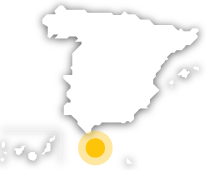The cold, rocky and rough Atlantic Ocean meets the warm, sandy and calm Mediterranean Sea at the shores of Ceuta, giving rise to a great variety of fish species that enrich the local cuisine. These are used to make delicious dishes that will please the most discriminating gourmets. These species includethe lazy turbot, which inhabits deep, sandy waters; silver anchovies like those from Málaga, and cephalopods, specially the delicious squids. Juicy Mediterranean lobsters and crayfish are also abundant. These are very light in colour, in high contrast with the dark, strong-tasting varieties from the Atlantic Ocean. It is precisely in the Atlantic where we find the magnificent red mullet and the white, almost transparent prawns that are known as "Nadas de Padrón". Also from the ocean are the excellent sole, sea bass, John Dory, grouper, magnificent tunas, bonito, sword fish from the Strait of Gibraltar and the delicious mackerel. It is from this last one that the folk from Ceuta get their nickname (caballa). Many more species thrive in these waters, all of them ensuring the great quality and freshness of the local seafood.
Although Ceuta belonged to Portugal for two hundred and fifty years, the proximity of Andalusia - especially Cadiz and Malaga - and Morocco has left its mark on its cuisine. The cocktail of flavours, smells and colours combined with excellent service guarantee the satisfaction of the customer will later form part of the many pleasant memories the visitor takes away with him, compelling him to return.
Dishes related to marmitaco
The melva hotpot, (fish very similar to bonito) is a traditional sailors' dish which, despite the distance, is related to the Basque "marmitaco". Its special character is obtained through the usage of ingredients such as cumin, crushed garlic and stock made from the carefully sieved skin and bones of the fish. This delicious, sea-tasting dish must not cooked for too long so that the melva fish does not dry up and lose its pleasant texture. Potatoes, tomatoes, peppers, onions and olive oil are the common ingredients that this fish dish has with the Basque "marmitaco".
Fish recipes
Another fish dish, called "bonito de almadraba" (netted bonito) is exquisite. Only a few hours after being caught, this fish is taken to the table in an earthenware dish, accompanied by lightly fried peppers and onions and covered with a tomato sauce enriched with ground spices. The result is an exotic Moorish flavour which the diner will not forget in a hurry. The bonito pie of Ceuta is cooked in a bain-marie, the fish is filleted and mixed with lettuce, boiled eggs, red peppers and breadcrumbs. All the ingredients are cut up very small and seasoned with black and white pepper. Beaten eggs are added and it is decorated with mayonnaise, strips of red pepper, capers or olives. The mackerel a la Mar Chica is prepared with slices of mackerel, approximately three centimetres thick, which are placed in an earthenware dish with carrots, small onions, white wine, oil, saffron, vinegar, peppers, cumin, bay leaves and salt and cooked very slowly.
Fruits and sweets
Ceuta receives many ingredients from its neighbour Morocco, depending on the season. These include small and delicious apricots, pears and crisp apples, sweet grapes, watermelon, melon, pomegranate.... and many other types of tasty fruit cultivated on the dry land. The "trenzas de Agustina" are prepared by making a dough out of flour, sugar, eggs, oil and orange, lemon and tangerine rind, to which a glass of aniseed liqueur is added. This dough is then made into plaits which are fried in honey until it is absorbed and then decorated with chopped almonds, pine nuts, crystallised fruit, chopped chocolate noodles and sometimes creme patissiere. They are absolutely delicious.
Christmas Food in Ceuta and Melilla
Ceuta and Melilla are Spain's two autonomous cities in North Africa. Their location is clearly reflected in their cuisine and it is easy to distinguish this influence on their Christmas menus. For example, in Melilla, the sweet or sour pastries called briouats are very popular, particularly the ones filled with seafood, meat or chicken. The blend of cultures is even more evident at the festive tables, where you can find a mixture of Spanish nougats, marzipan, and typical shortbreads with Moroccan sweets and cakes.


